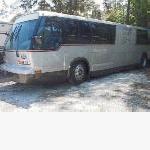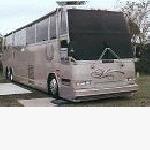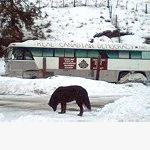| Author | Message | ||
| Roger Dalke (Roger_d)
Registered Member Username: Roger_d Post Number: 22 Registered: 8-2007 Posted From: 205.206.150.67 Rating: N/A |
Had my mc7 spray foamed, put on vapor barrier and screwed panelling to the roof and walls. Now the problem. On each screw head and on the panelling over the metal framework,water is collecting. Any idea how to get rid of it? Even though it is well insulated, the metal frames are the same temp as outside. Not impressed!  R R | ||
| john w. roan (Chessie4905)
Registered Member Username: Chessie4905 Post Number: 1768 Registered: 10-2003 Posted From: 71.58.71.157  Rating: N/A |
how about moisture from your breath and a propane heater? | ||
| Len Silva (Lsilva)
Registered Member Username: Lsilva Post Number: 323 Registered: 12-2000 Posted From: 72.187.35.208  Rating: N/A |
Unfortunately at this point, you need a thermal break between the metal fame and the paneling. Depending on how far along you are in the conversion. If possible, I would remove the paneling and add some wood strips to the metal frame members to attach it to. Even a 1/4" would help, but I would go a bit thicker than that. I think most folks add furring to the frame before insulating. | ||
| Roger Dalke (Roger_d)
Registered Member Username: Roger_d Post Number: 23 Registered: 8-2007 Posted From: 205.206.150.67 Rating: N/A |
No propane heater, just an electric radiator. And yes I was breathing!(not too heavy though!) However, I was trying to paint the panelling and noticed the water collecting. So the latex paint probably gives off h2o too. I keep thinking I've done lots of research before spending $$, but I just keep messin' up! Don't really want to remove the panelling to add strips, as this would leave a void and make everything smaller. But it was just me in there today, and I wonder how bad it will get with all five of us?! We would like to use this for ski trips, so it will see lots of cold on the outside. R | ||
| Don Evans (Doninwa)
Registered Member Username: Doninwa Post Number: 242 Registered: 1-2007 Posted From: 208.81.157.234  Rating: N/A |
If you don't have a vent in the ceiling I would plan one now. Remember that water vapor is lighter than air, hence the drops on the ceiling. A vent will let some of it out. The interior needs to be warmer than outside too. Depending on how much moisture is in the surrounding air, that may be all it takes. That paint puts a bunch of moisture in the air. Do you have a meter to measure the relative humidity in the coach compared to outside? We put a vent cover on one of the roof vents in our first bus and it stays wide open whenever the bus is not in use. Keeps the rain and snow out and the bus air fresh all winter. We do live in a relatively dry climate. Only got about 100" of snow last winter.  There are always dehumidifiers too. Good luck, Don 4107 | ||
| don goldsmith (Bottomacher)
Registered Member Username: Bottomacher Post Number: 265 Registered: 12-2000 Posted From: 72.152.137.154 Rating: N/A |
Latex paint is MOSTLY water, and it dries by evaporating the water into the air. Open as many vents as possible until it is thoroughly dry. It is flat or gloss paint? Flat will absorb moisture even after dry, enamel will repel. Good luck. | ||
| Jim Wallin (Powderseeker01)
Registered Member Username: Powderseeker01 Post Number: 46 Registered: 10-2008 Posted From: 208.68.48.77  Rating: N/A |
A vent in the ceiling will help some, but if you're using your bus in the winter your heat will go out quickly too which is nice in the summer, not so much in the cold. We are fulltiming in Colorado in our 4107, and condensation appears under the vista windows after showers and tea kettle operations when the temperature drops below freezing. We also have spray foam, but it was installed after the furring strips. Your easiest solution may be the dehumidifier route. | ||
| Rob Norgren (Robsedona)
Registered Member Username: Robsedona Post Number: 176 Registered: 11-2007 Posted From: 75.210.243.175  Rating: N/A |
"Unfortunately at this point, you need a thermal break between the metal fame and the paneling." The metal to the paneling will transfer cold and heat in and out of the room fast Furring strips Or even a another layer of paneling will help and Paint the Roof with a insulating Paint. Remember Dew Point and this point will cause rust in their also :-( | ||
| Glenn Williams (Glenn)
Registered Member Username: Glenn Post Number: 238 Registered: 6-2006 Posted From: 216.163.57.91  Rating: N/A |
I spray foamed, put in 1/4 inch luon attached to the bus ribs. Then I put my final paneling over that with glue and nails. No visible screws, no condensation. Good luck! Glenn | ||
| Pete/RTS Daytona (Pete_rtsdaytona)
Registered Member Username: Pete_rtsdaytona Post Number: 583 Registered: 1-2005 Posted From: 97.104.18.110  Rating: N/A |
I used Indoor/Outdoor carpeting (100% ozite) from lowes (the type without the rubber backing) glued to the vertical walls with carpet glue (takes a day or 2 to fully dry but lets you move the carpet slightly when appling - contact cement is final). This shields the screws from moisture and also provides a HUGE amount of sound deadening. For the ceiling can you just GLUE another panel to the ceiling (no nails) - I also used ozite on my ceiling but I glued the ozite to 2' x 5' - 1/8 plywood panels and let them snap into place on my curved ceiling - then used Decorative trim to cover the seams - they also sell "H" moulding to hide the seams You can speak in a wisper while traving 70 miles per hour Pete RTS/Daytona | ||
| doug yes (Dougg)
Registered Member Username: Dougg Post Number: 113 Registered: 1-2007 Posted From: 162.40.215.43 Rating: N/A |
The carpet sounds like the best solution. Our DL3 came stock with carpet like material on the ceiling and walls. Otherwise you can remove the panels and put self adhesive foam tape or butyl tape on the ribs and remount the panels. Screw heads could be painted with rubber based paint. | ||
| Bill 340 (Bill_340)
Registered Member Username: Bill_340 Post Number: 96 Registered: 7-2006 Posted From: 75.203.81.159  Rating: |
Pete does your wife Know you go 70 miles a hour.........See ya in arcadia, have a happy holiday | ||
| Jim Wilke (Jim Bob) (Pd41044039)
Registered Member Username: Pd41044039 Post Number: 421 Registered: 2-2001 Posted From: 184.0.0.219 Rating: N/A |
The bus is trying to tell you it wants to be in a warmer climate. Seriously, if you used adhesive (like construction adhesive along with the screws, you could probably remove the screws with no ill effect. Or maybe a 2 1/2-3" trim band of wood over the area where the ribs & screws are would prevent condensation. | ||
| clint hunter (Truthhunter)
Registered Member Username: Truthhunter Post Number: 546 Registered: 1-2009 Posted From: 24.129.237.18  Rating: N/A |
...fill the ribs with spary foam injected through a few holes drilled right through the paneling or glue the paneling on, holding it with screws until dry, remove the screws that are acting as the condensors. | ||
| clint hunter (Truthhunter)
Registered Member Username: Truthhunter Post Number: 547 Registered: 1-2009 Posted From: 24.129.237.52  Rating: N/A |
...or back the screw out one at a time, fill will foam-in-a-can and screw back in once set enough. Warning messy sticky stuff, were protection & have plenty of toxic acetone handy with paper towels. that will leave a good gob of foam around every screw. | ||
| Roger Dalke (Roger_d)
Registered Member Username: Roger_d Post Number: 24 Registered: 8-2007 Posted From: 205.206.150.199 Rating: N/A |
Thanks for all the good advice. I have three roof vents and a fantastic fan. But I wanted to keep the heat in!? All the tubing has been spray foamed as Clint suggests, but as it is a steel tube, the heat/cold transfers regardless of insulation inside. I guess the walls and panelling have to come out.  I was hoping for something magical, but will go with the thermal barrier idea. Thanks all! I was hoping for something magical, but will go with the thermal barrier idea. Thanks all!  R R | ||
| Robert Fischer (Rbt137)
Registered Member Username: Rbt137 Post Number: 17 Registered: 7-2006 Posted From: 71.111.48.236  Rating: N/A |
Rodger, I am regularly in the mountains in the winter. with the exception of the windshield, all windows are double pane. the roof has six vents. all will be closed except for (daytime) the kitchen, night time, the bedroom. ((in the case of over night guests, I will crack the vent in the living room)) How much any vent is opened is determined by how much condensate develops on the inside of the windshield. I rarely have condensate on the windshield and never on any dual pane glass. I also try to control snow (moisture) by leaving shoes outside when practical. fwiw. | ||
| R.C.Bishop (Chuckllb)
Registered Member Username: Chuckllb Post Number: 985 Registered: 7-2006 Posted From: 75.210.204.206 Rating: N/A |
Our coach has 6 roof vents, three sky lights. During hot summer days, we place foil bubble insulation in the skylights...would work in winter too, I imagine...also, in winter, we place it in the vents that are not used. Also use custom made "shades" over the side windows...three layer...to deal with the heat and the cold. Biggest culprit, as has been said so many times, is G L A S S...thermo or not. (thermo surely helps, however!) When the sun goes down, summer or winter, foil bubble insulation goes on windshields and rear glass...relatively inexpensive and very helpful (just like car windshield insulators). We lived in Almont, Colorado during the winter (25 below zero) and Las Cruces, NM in the summer (106+)in one of these vehicles and I can attest to the fact that if the glass is not taken care of, one can usually have a lot to "complain" about. FWIW, and as RJL says...HTH  RCB | ||
| john w. roan (Chessie4905)
Registered Member Username: Chessie4905 Post Number: 1772 Registered: 10-2003 Posted From: 71.58.71.157  Rating: N/A |
Don't panic. Your coach is just like a bathroom; you'll get condensation on all the interior, metal or not. You will need to ventilate, at least some. You could recess the screw heads and cover over them. A dehumidifier running occasionally would help. Till that paint dries, you will have a great deal of moisture. | ||
| R.C.Bishop (Chuckllb)
Registered Member Username: Chuckllb Post Number: 986 Registered: 7-2006 Posted From: 75.210.204.206 Rating: N/A |
JWR...whoooo xactly are you talking to???.  RCB | ||
| john w. roan (Chessie4905)
Registered Member Username: Chessie4905 Post Number: 1773 Registered: 10-2003 Posted From: 71.58.71.157  Rating: N/A |
Not like YOUR bathroom Chuck; more like one that has a shower and vent fan and an actual flushing toilet.  | ||
| David Evans (Dmd)
Registered Member Username: Dmd Post Number: 398 Registered: 10-2004 Posted From: 173.77.211.93  Rating: N/A |
Redoing the floor has turned into redoing the rear walls and roof. I had isulated once before with regular paperbacked insulation over 10 years ago. The walls had held up fine, the roof insulation was damp around the rear roof vent which might be leaking around the outside screws. The metal was and is coated with coal tar of some kind from the factory. should i use a vapor barrier this time around? I was planning on using insulating board with the aluim foil facing outward black side inward and filling any spaces or cracks with the expanding foam. Let me know what you think. Thanks | ||
| Roger Dalke (Roger_d)
Registered Member Username: Roger_d Post Number: 25 Registered: 8-2007 Posted From: 205.206.150.130 Rating: N/A |
David- I noticed that the inside wall over the structure was the same temp as the outside sheetmetal. I've spray foamed, but will now be adding narrow strips of 3/8 inch wood over all the structure, with counter sunk screws. Between the strips I'm putting 3/8 foil backed styrofoam.(They use it for extra insulation before putting siding on houses) I did put vapor barrier over the spray foam, but it was condensing on the inside of the plastic. As I don't think I ever want to do this again I'm trying to do everything right.  For the cost involved, I would put the barrier on. I would also insulate over the structure. Lots of good advice in this thread. R For the cost involved, I would put the barrier on. I would also insulate over the structure. Lots of good advice in this thread. R | ||
| David Evans (Dmd)
Registered Member Username: Dmd Post Number: 399 Registered: 10-2004 Posted From: 173.77.211.93  Rating: N/A |
Thanks Roger, i spent about an hour in the archives last night and one of my questions is the vapor barrier. I dont want condenstaion inside the plastic tho! | ||
| Roger Dalke (Roger_d)
Registered Member Username: Roger_d Post Number: 26 Registered: 8-2007 Posted From: 205.206.150.254 Rating: |
Just to clarify; The moisture was on the coach (interior) side of the plastic. Not between the barrier and insulation.  R R |